Six features every travel agency software must have
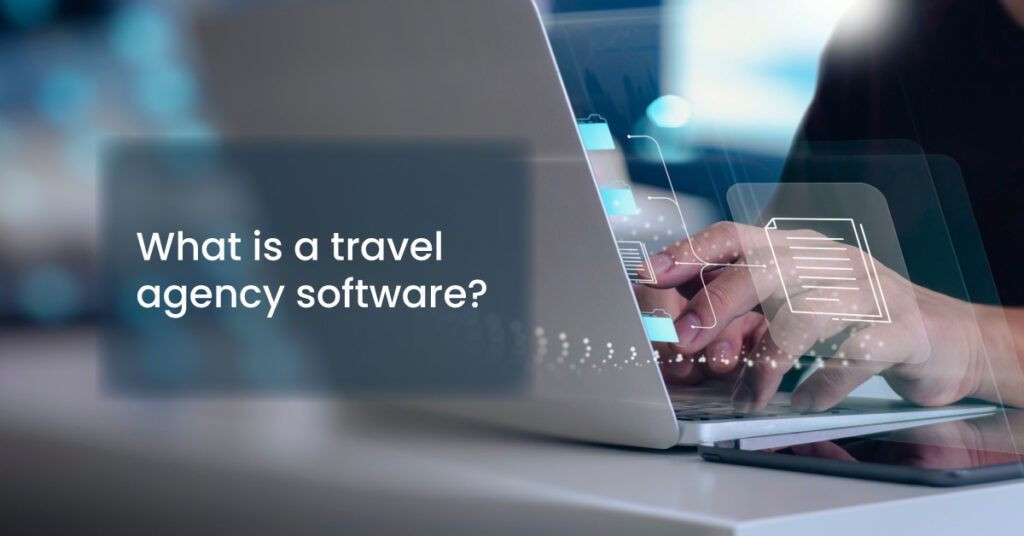
A travel agency software is all-in-one travel-based software that helps you manage and automate your sales, booking, and finances operations. If you are a travel agency, irrespective of your business structure – B2B, B2C, or D2C, a travel agency software is a must for you. However, not all travel agency tools are helpful for your business. The market of service providers is enormous. We are helping you narrow down your choices by listing the features you must look for in travel agency software. But before we get to that, let us just quickly understand the basics of travel agency software. What is travel agency software? Travel agencies have broad portfolios of travel products, including accommodation, travel, transfers, and activities. They need an integrated application to manage both front and back-office activities. A travel agency software works as a nifty tool that helps travel agencies with multiple functions like supplier connectivity, custom pricing, tour package creation, customization, quotes, itinerary creation, etc. Also, a travel agency tool helps travel agencies in their marketing and finance functions either directly or by connecting with other crucial applications travel agencies use for these domains. Though, all the leading travel agency tools offer the functions we discussed above. This article aims to help you with non-negotiable variables of travel agency software – the must-have features of a travel agency application. As we talk through the following key features of the travel agency application, you will better understand where to pull the weight while choosing a software for your travel business. Six must-have features for travel agency software For a product to qualify as a good travel agency tool, it must have the capability to accommodate and manage the varied offerings of a travel agency. Here we are not naming brands for you. Instead, we focus on something more tangible, “the features” which put together constitute a great travel agency software built for growth. So, without further ado, let’s look at these features one at a time: 1. Hotel Contracting All the travel agency applications have a reservation management system. Still, you need a hotel contracting module within your travel agency software to use the reservation system to its true potential. It is the first feature you should check before finalizing the vendor. The reason behind this is simple – irrespective of the size and nature of your travel agency, you will always have a need to upload direct contract hotels. Thus, the hotel contracting module becomes a must. 2. Dynamic Tours Module In today’s world, travel dynamics change quicker than we could imagine. The Covid-19 pandemic was a reminder of the same. So, you need flexibility from the travel agency tool, so you can always customize your offering aligning with the demands of the time – the dynamic tours module of travel agency software gets you that flexibility. 3. Quotation System The quotation module is another key must-have system that must feature in your travel agency tool. The module shall have an exclusive integration capability for agents and travel partners. The system shall allow your agents to simultaneously create multiple quotes for different hotels, tours, flights, and meals. 4. Ticketing and Tracking The ticketing module is the most crucial feature of any travel agency tool. Every travel management tool will have it, yet you need to make sure your software allows you end-to-end tracking of all your confirmed, canceled, redeemed, and issued tickets. 5. User Management System Time is cost, and in an industry like travel, where competition is stiff, you wouldn’t want to lose customers because the travel management system is inefficient. The user management system gives you that desired pace by allowing your customers to quickly log in to your travel portal directly by their social profiles. 6. Integrations Most travel agency tools allow integration with major GDSs, like Amadeus and Sabre, which is a great addition. Yet, your travel agency software must allow third-party supplier integrations like tours, attractions, bed banks, etc. The integrations enable you to access greater volume for your travel agency. Recommended: Top Five Travel Management Software Solutions in 2022 The above list of features is not exhaustive. The services will vary with the providers, but the features mentioned above shall be a great start to your drive to secure the best travel agency application for your business. The larger tip is to get the overall module right. The functions of travel agency software you learned in this piece are a non-negotiable necessity. Anything beyond is cushioning, which you can always trade with your vendor.
Leveraging hotel guest messaging system to enhance customer experience

A hotel guest messaging system is a communication platform that allows guests to interact with hotel staff in real time via text messages, voice commands, or chatbot interactions. Hotel guests who use messaging services during their stay rated their overall experience 8% higher than those who did not. A study found that hotels that have implemented messaging systems have seen a 30% decrease in guest complaints. The hospitality industry has never been more competitive than it is today. The good news is that classic differentiators like “customer service” can still put you ahead in the race. While the change is that traditional methods of boosting customer experience are no longer relevant. With guests now having access to a plethora of options and platforms, hotels have to provide an experience that is not only memorable but also convenient and efficient. One way to achieve this is by leveraging a hotel guest messaging system. How does it work? What are things to keep in my while implementing it? What are the prominent use cases and their success rate? We answer all these questions in this blog post. A hotel guest messaging system is a communication platform that allows guests to interact with hotel staff in real-time via text messages, voice commands, or chatbot interactions. This system can be integrated with a hotel’s existing property management system and can be accessed through a guest’s smartphone or tablet, or through a hotel’s in-room tablet or TV. When implementing a hotel guest messaging system, it is important to ensure that the system is easy to use and that guests are made aware of its availability. This can be done by including information about the system in guest check-in packets or by displaying signs in guest rooms and public areas. Additionally, it is important to train hotel staff on how to use the system effectively and efficiently so that they can assist guests with any questions or issues that may arise. Efficiency and Convenience One of the primary benefits of a hotel guest messaging system is that it allows guests to easily access information and assistance without having to wait in line or call the front desk. For example, guests can use the system to request extra towels, ask for restaurant recommendations, or schedule wake-up calls. This can greatly improve the guest experience by providing them with the information and assistance they need quickly and efficiently. According to a study by the Cornell University School of Hotel Administration, guests who use messaging services during their stay rated their overall experience 8% higher than those who did not. Management of guest complaints A ResearchGate report found that hotels that have implemented messaging systems have seen a 30% decrease in guest complaints and a 20% increase in guest satisfaction. Effective Management of Guest Requests and Complaints Another benefit of a hotel guest messaging system is that it can help hotel staff to better manage guest requests and complaints. With all interactions being logged into one central location, staff can easily access and respond to guest inquiries and track their progress in real time. This can help to ensure that all guest requests are handled promptly and professionally, which can lead to improved customer satisfaction Personalization of the Guest Experience A study by Deloitte found that personalized offers result in an average of 20% more revenue per guest. A hotel guest messaging system can also be used to personalize the guest experience by providing guests with tailored recommendations and offers. For example, if a guest is celebrating a special occasion, the system can automatically send them a message offering complimentary champagne or a discount on spa services. This can help create a more memorable and enjoyable experience for guests and increase revenue for the hotel. When it comes to setting up and managing a hotel guest messaging system, you should consider the following: Appoint a dedicated team or person responsible for monitoring and responding to guest messages promptly. Establish clear guidelines and protocols for responding to guest messages, including a script for frequent questions and concerns. Regularly review and analyze data on guest interactions to identify areas for improvement and adjust as needed. A hotel guest messaging system can be a powerful tool for enhancing the customer experience. By providing guests with easy access to information and assistance, and by helping hotel staff to better manage guest requests and complaints, a hotel guest messaging system can help to create a more enjoyable and memorable experience for guests. Additionally, by personalizing the guest experience and providing tailored recommendations and offers, a hotel guest messaging system can also help to increase revenue for the hotel. With the right implementation and training, a hotel guest messaging system can be a valuable asset for any hotel looking to improve customer satisfaction. Vervotech is a leading Hotel Mapping and Room Mapping API that leverages the power of AI and ML to quickly and accurately identify each property listing through the verification of multiple parameters. With One of the industry’s best coverage of 98% and an accuracy of 99.999%, Vervotech is quickly becoming the mapping software of choice for all leading global companies operating in the travel and hospitality industry. To learn more about Vervotech and the ways it can enhance your business in the long run contact us: sales@vervotech.com
Descriptive Content: What is it, and how can it impact the travel company’s revenue?
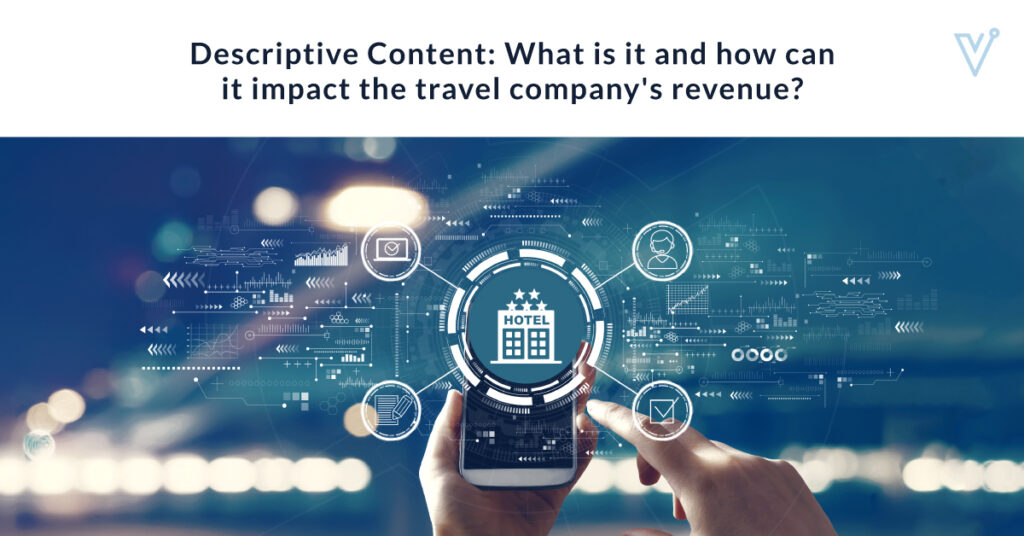
As a travel business, it is great to convert your website’s lookers to bookers- but how do you get your visitors to actually book on your website? Most website visitors don’t book their hotel as soon they find them. Instead, they research and read reviews before making their final purchase decision. Suppose you are a travel company with steady traffic coming from multiple channels but struggle to convert them into your customers. In that case, you need to think about your website’s descriptive content. A website’s descriptive or static content includes hotel information such as hotel name, hotel property photos, hotel amenities, room descriptions, geocodes, hotel policies, and more. Each hotel may showcase the stay experience that they offer by using descriptive content. In fact, descriptive content changes are less frequent than dynamic content but need to be updated regularly. Did you know your website’s descriptive content has the power to increase your website bookings and revenue? Descriptive content or static content significantly impacts travelers’ booking decisions as today’s modern traveler wants accurate and complete information before booking their hotel. So let’s understand in detail descriptive content and its impact on your business revenue. How descriptive content can impact your business revenue If the descriptive content is not regularly updated, then OTAs can face poor customer experience, inaccurate hotel information, missed business opportunities, and revenue losses. Here’s a breakdown of each hotel’s content and how it impacts on your business revenue. 1. Hotel property images According to a study, photography is the most important factor for travelers when scanning for hotels on OTA platforms. High-quality hotel images improve the travel booking experience for customers, which can lead to better booking volumes. Also, another research revealed that better hotel photos receive 150% more traveler engagement. So, if you want better customer engagement, higher booking volumes, then focus on improving the quality of hotel images. 2. Hotel amenities Another descriptive content that can impact your revenue is hotel amenities. If your website showcases the wrong amenities, it can easily impact the traveler’s stay experience. For example, a customer discovered from your website that the hotel property is pet-friendly and books the hotel only to realize reaching the hotel that the property is not pet-friendly. This leads to a dissatisfied guest experience and negatively impacts your brand’s reputation. There are various automation tools that audit the descriptive content of the hotel listings to ensure the customers get what they pay for. 3. Room types There are over 30 different names of hotel rooms, and most hotels categorize hotel rooms based on factors like room size, bed types, interior design, room layout, etc. This can easily confuse the customer during their travel shopping. So, make sure your website is free from duplicate room content through the room mapping tool. Accurate room information gives the customer confidence during booking and increases your brand loyalty, thus increasing your revenue and booking volumes. 4. Geo coordinates and hotel address While geo coordinates are static content, if they are inaccurate for any hotel property listed on your website, it can harm your revenue and brand image. Wrong hotel addresses will lead to bad reviews, dissatisfied customers, and lower booking volumes. Curated content tools powered by AI/ML algorithms can ensure your hotel database has accurate hotel addresses. Improve your descriptive content with Vervotech Curated Content Apart from the mentioned descriptive content, there is over 20+ hotel content that can impact your business revenue too. Our intuitive AI-driven Curated Content tool uses several parameters to identify, segregate and de-duplicate descriptive and illustrative hotel content from multiple suppliers. Below is an example from our curated content tool, which accurately curated the entire hotel descriptive content of Atlantis, The Palm. Image: Vervotech Curated Content Tool Dashboard We even deliver accurate location mapping, such as Hotel to city mapping Point of interest mapping Stadium mapping Train stations mapping Airport mapping As we conclude, if you want your travel business to have a competitive advantage and increase revenue, invest in streamlining descriptive content with automated tools such as curated content. Vervotech Curated Content tool curates over 38 hotel attributes with 99.999% accuracy with 98% coverage so that every accommodation provider delivers a paramount customer experience and gains higher revenue.
What are hotel search patterns? And how can you optimize them to users’ intent?
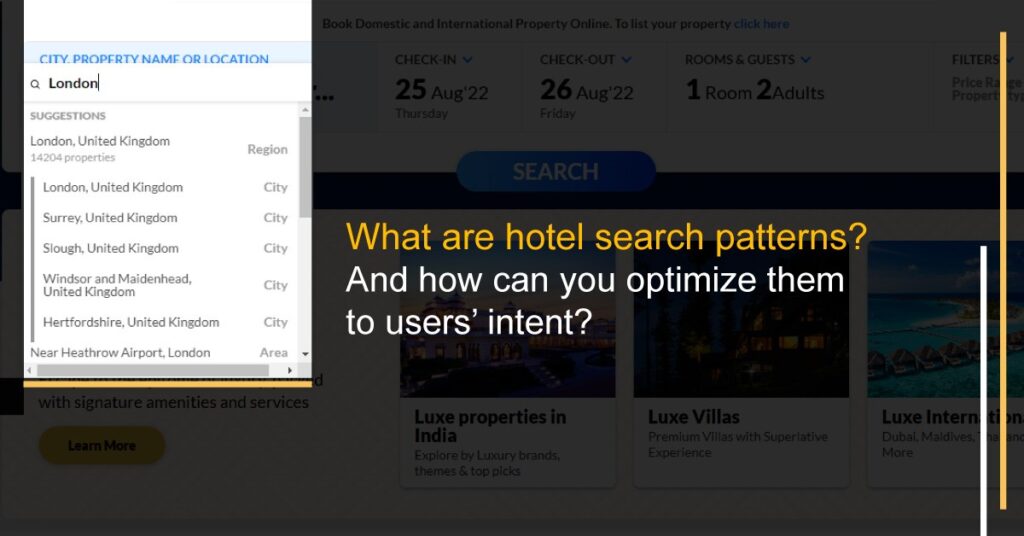
People have multiple biases when they come online to book or browse hotels. It is because they all have an abstract image of the experience they are going to have in a property. And their biases affect their search inputs. We call them hotel search patterns. As a travel business, hotel search patterns can go against you as well. Suppose if the search results are too far from customers’ original imagination, they are likely to drop off your website. There are many other ways it can go wrong for you. We will deal with those scenarios further in this piece. For now, let us stick to how you can make sense of these hotel search patterns, and how you can make them favorable for you. As an online travel enterprise, you already have data on what your audience is putting in your search box. Also, your suppliers provide you with data like hotel ids, airport codes, location codes, and alternate location codes. You can use multiple combinations of supplier data to display relevant results against a variety of search queries. Now, the question that might pop up in your mind, how you refine those search results. So, next up, we address the question for you with solutions. Four ways to refine hotel search results There are several methods and approaches that you can use to derive refined search results. Here we will walk you through four primary and proven techniques to fetch the most refined search outcomes. Radius based approach In the radius-based approach, you decide on a standard radius against all potential hotel search queries. And account for all the geotags within that standard radius. This approach helps travelers find the relevant hotels, precisely in the area towards which they already have an inclination. Hence, you maximize discovery and help your conversion chances through a radius-based approach. The approach is good for use cases like searching on zip codes or specific points of interest like ‘Statue of liberty.’ Polygon based approach The polygon-based approach helps you cover a broader spectrum of locations. Let us understand with an example: Suppose there is a search query for a city. With the polygon-based approach, you can account for latitude, longitude, and geotags of the entire periphery of the city. The above exercise will ensure you do not miss out on any property against a search query. The approach is good for use cases like searching on zip codes or specific neighborhoods. E.g., Southeast Austin. Matching location IDs with hotels As an online travel website, sometimes you want very granular control over which hotels to be shown when searching for any specific location irrespective of the geographical boundaries of the location. For example, while searching hotels in Paris, FR, you want to fetch the hotels from Montreuil which is one of the nearby localities the core of Paris city. To cater such hotel search behaviors, you must build your own location content database from multiple location content sources like preferred supplier location content, third party services like Google, TomTom, Four Square etc. Then you can map/tag the set of hotels against every location in your own location database. In short, we have a very customized and controlled mechanism to show the hotels for every location. This approach helps you display relevant search results when the consumers are not particular about the hotels but specific locations and attractions. The approach is best not only for use cases city-based search but also when you are searching for hotels by point of interest, airports, stadiums. E.g., Times Square. New York Use provider specific location Ids As we know, most of the leading hotel suppliers have their location content and they have optimized and customized the search results for different regions or cities. So, instead of re-inventing all those search engine nuances, you can leverage their location content directly on your platform. The obvious pre-requisite is to have the formal agreement to access that location content. This approach works best when your supplier strategy on your platform revolves around a few specific suppliers. How can you optimize hotel search results to relevance? So far in this article, we have discussed customer biases and potentially how they can affect hotel search patterns. We also examined how you can refine your search results using different techniques and methods. Now, we come to optimization, how you can optimize your refined search results to relevance. We are listing a few recommendations for you, and it is not an exhaustive list. But these optimization methods or recommendations give you a great chance to make your search results more precise and relevant. Personalized searches You can make your search results relevant straight up by displaying personalized results. It is an excellent technique to offer quick value to recurring customers. You already have data about what they like, the frequency, the budget ranges, preferred hotel amenities, etc. You can make it easier for them the moment they enter a query in your search box. Top selling properties In general, travelers are risk averse when it comes to choosing a property. They are more likely to go with properties already doing well and have recently offered value to their guests. So, displaying top-selling properties in response to search queries could be a great proposition for your business. Review based searches It is the age of proof of concept and social proof. As we mentioned previously, to minimize the risk or the likelihood of an unpleasant experience, travelers trust the experiences of past travelers and their feedback. So, displaying high-rated properties in response to hotel searches can make the drill easier for you visitors. Supplier specific properties The data you get from your suppliers is not linear in terms of quality. You can identify the suppliers that deliver a better look-to-book ratio and tie only their data to your search box. Recommended: Leading Hotel Mapping Tools in 2022 Conclusion! When travelers come to your website and search, the last thing you want is that no
7 Steps to Start an Online Travel Agency Business
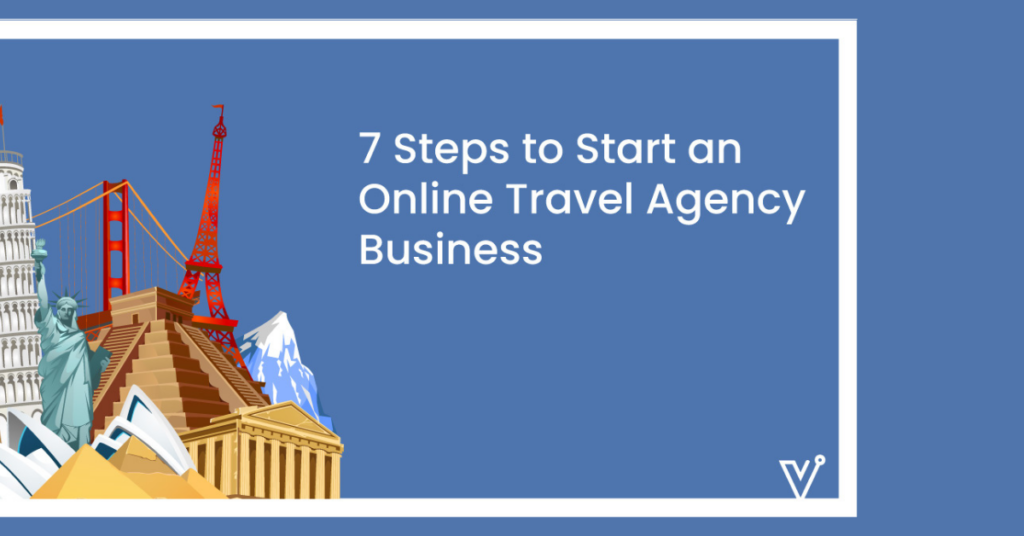
We live in the startup era, where budding entrepreneurs are passionate about turning their dream project into a lucrative business. Launching a travel agency business can be equally rewarding and intimidating in this booming entrepreneurial era. According to a study, 71% of businesses fail within 10 years of their operation. Turning your business idea into a travel company and getting it off the ground might seem challenging. But it would be best to start with proper planning, make appropriate financial and legal decisions, and much more to keep it operational. Online travel agencies or OTAs are the most dominant players in the travel market, with a share of $561 billion in 2021. OTAs are one-stop-shop to search and book everything from flights and accommodations to excursions, making it hassle-free for travelers to book for their upcoming trips. A new research by Statista predicts that by 2025, the OTA market is expected to reach $833.5 billion. 7 Steps to Start an Online Travel Agency Business Owning an OTA business in 2022 is lucrative as 81% of travelers heavily rely on OTAs to search and book for their upcoming trips. Let’s now dive into the top 7 steps that you need to take to start your travel agency business. This post can be a blueprint for launching your online travel agency. 1. Develop a Business Plan Your online travel agency business plan will be a roadmap for establishing your idea. The document will showcase every aspect of your business- company goals, vision, business strategy, financial plan, products or services, your target audience, marketing strategy and strategic partners: These can be suppliers and tech as well. Developing a business plan will keep you on track with your vision. Also, to stay competitive in the constantly evolving travel market, you need to revise your business plan constantly. Read More – The importance of responsive web design for OTAs and its implementation 2. Identify your Niche Market Since the travel industry is highly dynamic and competitive, you need to identify and choose which travel market do you want to target. Start with market research to understand your potential customer needs. In this step, you must focus on: Target audience travel behavior and preference Types of travel products such as hotels, flights, excursions, cruises, etc. to sell Finding niche travel markets Why is it essential to find your niche to start an OTA business? Well, the competition is fierce with brands like Booking.com, Tripadvisor, Kayak, Expedia, and much more. You need to stand out and compete efficiently in the travel market. And this can be possible by being an expert in your niche and answering every trip-related question the modern traveler asks. According to a research some of the booming travel niches that your business can dive into are: Bleisure travel Adventure travel Healthcare tourism Eco-friendly or sustainable tourism Gastronomy tourism Wellness and spiritual tourism Heritage and cultural tourism Recommended: Five Ways World Travel And Tourism Industry Digitalizing Journeys 3. Find the Right Mix of Partners and Inventory Suppliers The next step is to develop fortifying partnerships that can help your business grow. During the early stage of your startup, you need to work with multiple suppliers or providers to sell your travel products and make money through commissions. Let’s say your niche is heritage and cultural tourism in Italy. To sell your travel products and grow effectively, you must connect with a wholesaler with the largest hotel inventory, airlines, and other travel services. Talk to various providers, suppliers, compare their prices, services, and the commissions you might earn and then decide on the partnership. 4. Organize your Tech Platform With a business plan, niche and partners in place, it’s time to build a technology platform. Focus on these five main tech platforms: Search engine for customers to book Booking engine for automation of OTA workflow Back office for business operations Commission engine Recommendation engine to enhance customer experience It is difficult to work independently, and that’s why it’s ideal to integrate booking engine and other third-party APIs (flight search, hotel booking by suppliers, NDC, hotel mapping, car rental booking, payment gateways, CRMs) to your website for a hassle-free user experience. 5. Register your Online Travel Agency Business This is a crucial part of your business. With major tasks off your plate, it’s time to make your travel business legal by registering with the government. Here is the checklist to do so: Choose your business name Apply for licenses and permits as per your local laws Apply for business insurance Invest in accounting software 6. Gain Accreditation Accreditation will make your travel agency business credible. Obtain accreditation from IATA, ARC or any other reputed travel organization, contracts from GDS. This accreditation will review your industry experience, finances and even provide training and support to flourish successfully. Recommended: How Can IATA Travel Pass Help Countries Reopen Borders? 7. Financial Plan To successfully start your online travel business, you will need sufficient capital. There are different ways of funding capital. Some of them are: Personal savings Credit cards Money from family and friends Venture capital Angel investors Crowdfunding Small business loans and grants A combination of these funding sources can help you get off the ground. To secure this capital, you need to have a financial plan of how much money you need to raise and how your business will make a profit. You are now set to take off your online travel agency business with these essential steps. It can be daunting initially, and your startup might have roadblocks, but stay dedicated and remember these steps to start and grow your new business seamlessly.
Experiential travel: The concept, the market, and insights on starting the segment
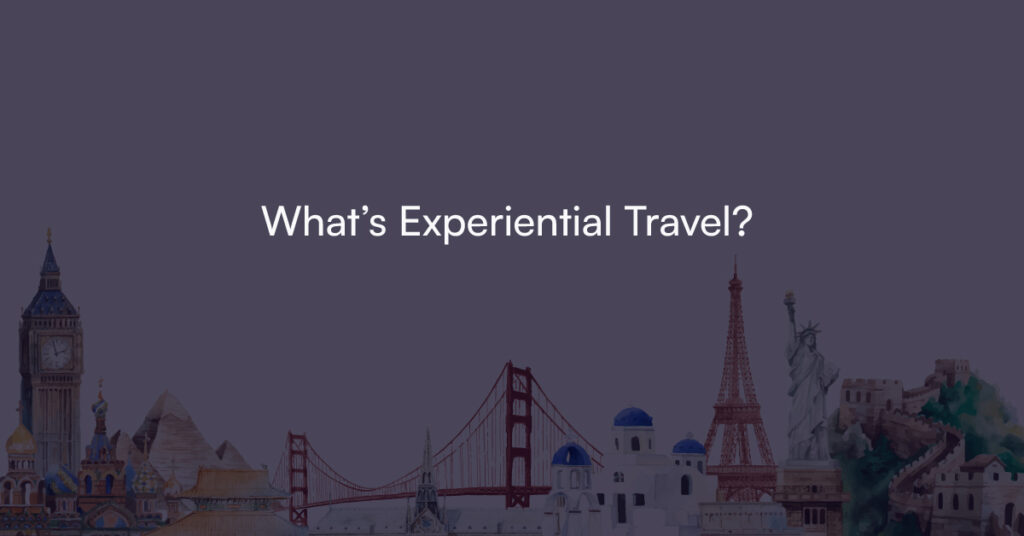
As per a recent survey, millennials are about one-third of the world’s population, and when they travel, a whopping 86 percent travel for experience. As many as 60 percent of them consider the authentic culture of the destination as the essential constituent of their trip. It indicates evolving expectations of the travelers from the destination of travel. They want to go beyond guided tours and have experience-driven trips; that’s why there is an exponential rise in experiential travel. Experiential travel primarily combines cultural exploration of the destination and activity-based experiences. It could be actively engaging with a destination’s community, getting to know their culture, food habits, their philosophy of life, and livelihood. Or it could be less intimate, where travelers engage in activities that are true to that destination. Generally, the “authenticity in travel” is getting more critical. People no longer want to visit a place and spend all their time gazing over the structure of the property they are staying in; with every new destination they travel to, they look for a unique experience. However, if you look for the term experiential travel, you will hardly find it in the travel market. Because the majority of the players in the travel industry package it as “adventure travel” or “experience travel.” Some luxury travel brands like Scott Dunn from the UK use and market the term experiential travel. Scott Dunn describes it as “Travel is by its very nature ‘experiential,’ but many of us now seek experiences that connect us to cultures and people in a more meaningful and enriching way. If you find yourself hankering for a more fulfilling travel experience that reinforces the things that make life worth living and is aligned to your personal values, you’re not alone”. Hence, only a few players in the travel market are positioning and marketing “experiential travel,” while the market size is huge. Per Fatbit’s estimates, the segment will reach US$266.7 Trillion in value by 2027. The segment is expected to grow at a CAGR of 7.7 percent. So, it poses a tremendous opportunity for the players in the travel market to come up with more “experience travel” offers, position and advertise them to cash-in this opening. Before you venture into the experiential travel segment, there are a few grounds you will have to cover. Here, we are detailing four crucial factors you should consider before starting an experience travel business. Delivery To manage efficient delivery, you have to organize your sources. You can assume you will operate in a market where the end consumers are highly aware of their choices. So, the delivery should be targeted and precise. You can achieve this by having a good mix of suppliers, partnering with resellers, and being available on all good marketplaces. Also, to boost personal sales deploy POS and channel manager. Positioning and Marketing The positioning of the offering will determine how you will fare in this segment in the long run. Identify your market, and you already have the story of “experience travel.” Yet, you must find a differentiator in terms of what you add to the story, work on your search engine optimization, leverage social media, and paid ads to position your offering. You will be good to go. Presence We mentioned SEO, Social, and Paid Media. All this will come into play and become a force when you are available on all possible online mediums. When we say all mediums, we mean don’t discount a channel, don’t assume you don’t need an IOS app. Test and scale your presence everywhere, from the web to mobile apps. Viability Experiential travel is directly related to localities and communities. Indeed, they will get incentives when you do business with particular communities and localities. But you have to keep sustainability at the top of the pyramid, keep your operations green, and maximize social benefits for people who are not directly involved in your business. Once you check these boxes, you can certainly build a viable and sustainable business on experiential travel. Recommended: Is Bliesure The Future Of Business Travel? In this piece, we detailed “how” many travelers are pivoting towards experience travel from conventional travel, the potential of the segment, and how you can introduce experiential travel on your platform with caution and efficiency, also for sustainability. The possibility of “experience travel” is there in numbers, and it could very well be the future of travel. Vervotech is a leading Hotel Mapping and Room Mapping API that leverages the power of AI and ML to quickly and accurately identify each property listing through the verification of multiple parameters. With One of the industry’s best coverage of 98% and an accuracy of 99.999%, Vervotech is quickly becoming the mapping software of choice for all leading global companies operating in the travel and hospitality industry. To learn more about Vervotech and the ways it can enhance your business in the long run contact us: sales@vervotech.com
The importance of responsive web design for OTAs and its implementation
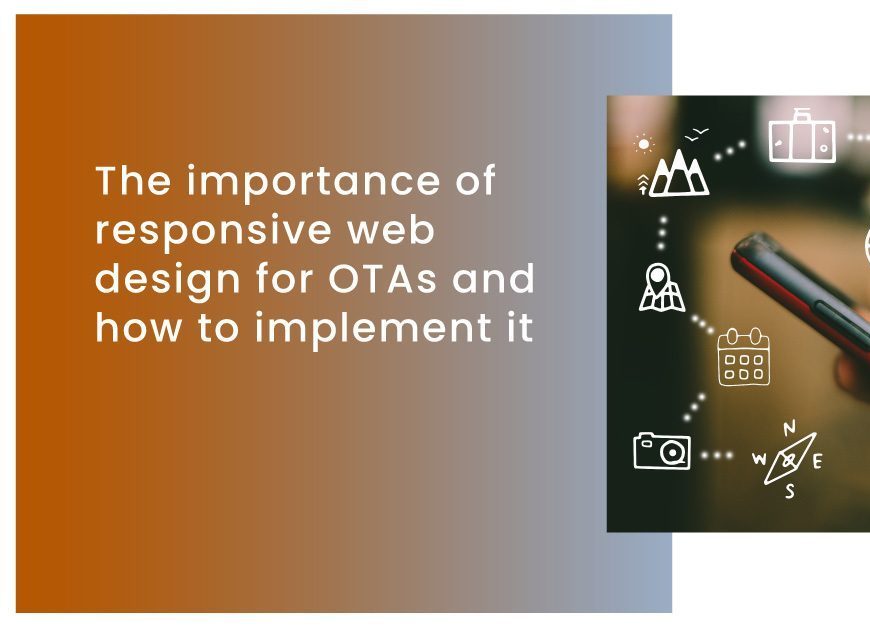
Your website is your most important asset as an online travel agency (OTA). It’s where customers come to browse, compare prices, and ultimately book their travel plans. But with so many different devices and screen sizes on the market today, creating a website that looks great on all of them can be challenging. That’s where responsive web design comes in. In this blog post, we’ll discuss the importance of responsive web design for OTAs and how to implement it effectively. We’ll also provide real-life examples and data to demonstrate the benefits of responsive design for your business. Responsive web design (RWD) is a design approach that enables web pages to render well on different devices and screen sizes. With RWD, a website’s layout, content, and images are adjusted automatically based on the screen size of the device being used to view it. For example, if a customer visits your OTA’s website on a desktop computer, the site will display a full-size layout with multiple columns and large images. However, if that same customer visits your website on a mobile device, the site will adjust to a one-column layout with smaller images optimized for mobile screens. There are several reasons why responsive web design is crucial for OTAs. First and foremost, it improves the user experience. If customers have difficulty navigating your website on their mobile device, they will likely get frustrated and go to a competitor’s site instead. According to a Google survey, 61 % of users said a bad mobile experience made them less likely to engage with a company. Additionally, a staggering 41% of users said they would likely visit a competitor site in such a scenario. Another reason why responsive design is essential for OTAs is that it improves search engine rankings. Google has stated that it prefers responsive websites because they provide a better user experience. Therefore, responsive sites tend to rank higher in search engine results pages (SERPs) than non-responsive sites. Additionally, responsive design can save OTAs time and money by eliminating the need for a separate mobile site. Instead of maintaining two locations, one for desktop and one for mobile, responsive design allows OTAs to have one site that works well on all devices. To understand the benefits of responsive design, let’s take a look at a few examples of OTAs that have implemented this approach effectively. Expedia Expedia is one of the world’s largest online travel agencies, and its website is an excellent example of responsive design in action. When viewed on a desktop, the site has a full-size layout with multiple columns and large images. However, when viewed on a mobile device, the site adjusts to a one-column layout with smaller images optimized for mobile screens. Booking.com Booking.com is another OTA that has implemented responsive design effectively. The site adjusts its layout and content based on the screen size of the device used to view it. Additionally, the site’s search function is prominently displayed at the top of the page, making it easy for users to find what they want. Now that we’ve discussed the benefits of responsive design and provided examples of OTAs that have implemented it effectively, let’s take a look at how to implement it for your own OTA. 1. Use a Responsive Web Design Framework There are several frameworks available that can help you implement responsive design effectively. Popular options include Bootstrap, Foundation, and Materialize. These frameworks provide pre-built templates and components that can be customized to fit your OTA’s specific needs. Read More – How to optimize an OTA website for search engines 2. Optimize Images and Media Images and media can significantly impact the loading time of a website, especially on mobile devices. To ensure that your site loads quickly and efficiently, it’s important to optimize images and media for different screen sizes. It can be done using tools like Adobe Photoshop or online services like TinyPNG. 3. Prioritize Content When designing smaller screens, it’s essential to prioritize content and ensure it’s easy to read and navigate. Consider using larger font sizes and minimizing the text on each page. Additionally, use clear calls-to-action to guide users towards desired actions, such as booking a hotel room or flight. 4. Test on Different Devices and Screen Sizes To ensure your site looks and functions appropriately on different devices and screen sizes, it must be tested thoroughly. It can be done using tools like BrowserStack or physically testing various devices. Make sure to try it on both iOS and Android devices and different screen sizes and orientations. Recommended: How To Optimize An OTA Website For Search Engines And Improve Online Visibility In today’s mobile-first world, responsive web design is essential for online travel agencies. By providing a better user experience, improving search engine rankings, and saving time and money, responsive design can help OTAs stay ahead of the competition. Using a responsive web design framework, optimizing images and media, prioritizing content, and thoroughly testing, OTAs can implement responsive design effectively and provide a great user experience on all devices. Vervotech is a leading Hotel Mapping and Room Mapping API that leverages the power of AI and ML to quickly and accurately identify each property listing through the verification of multiple parameters. With One of the industry’s best coverage of 98% and an accuracy of 99.999%, Vervotech is quickly becoming the mapping software of choice for all leading global companies operating in the travel and hospitality industry. To learn more about Vervotech and the ways it can enhance your business in the long run contact us: sales@vervotech.com
How to optimize an OTA website for search engines and improve online visibility
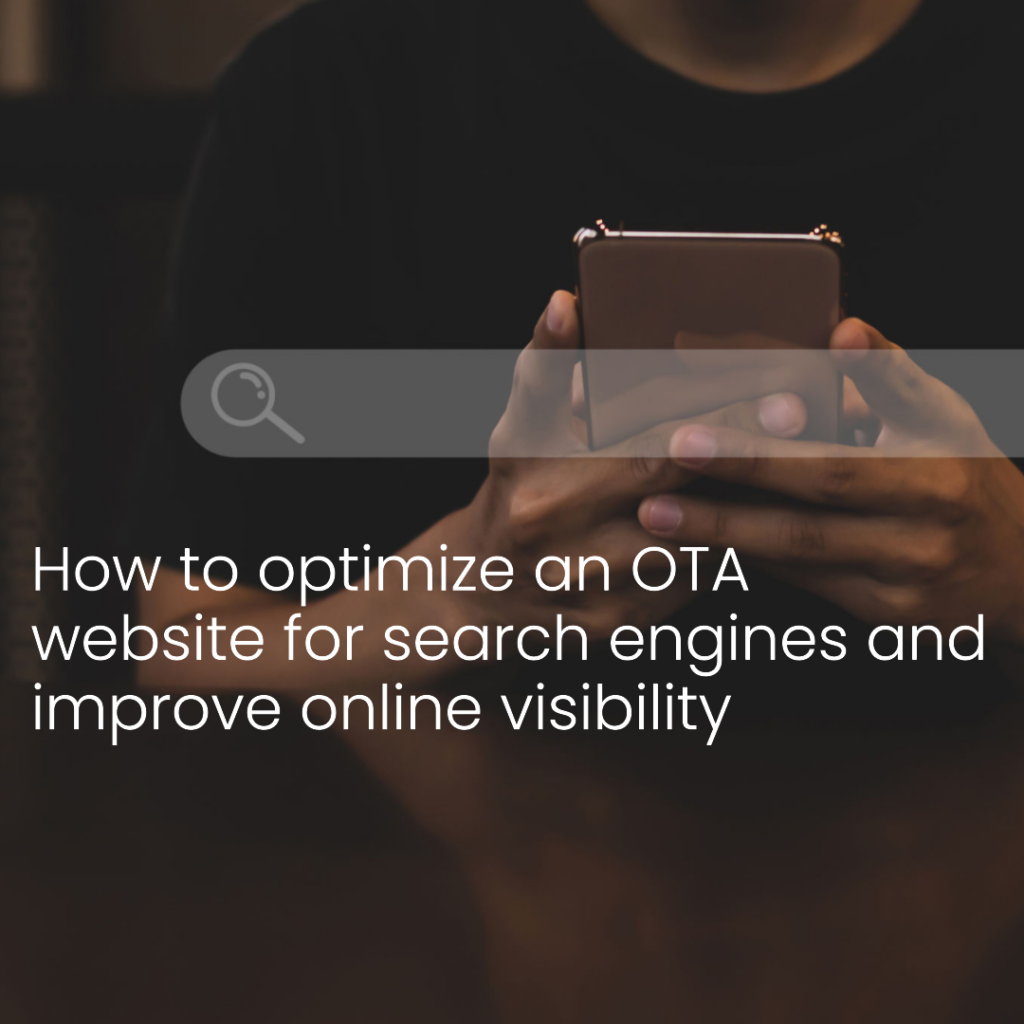
As the travel industry becomes increasingly digitized, online travel agencies (OTAs) are crucial to travel planning and booking. Over 60% of leisure travelers find and book stays online. As an OTA, it’s excellent news for you. However, as you already know, a multitude of OTAs are cropping up worldwide as the online travel market expands. So how do you compete? How do you remain relevant in such a crowded market? Optimizing your OTA website for search engines could be one of your answers. SEO can help you maximize your online visibility, appear in the booking cycle most of the time, and convert customers when travelers make a buying decision. Here, in this blog post, we’ll explore some key strategies for optimizing an OTA website for search engines. Search engines are evolving. They are continuously making efforts to make content helpful for the users. Since 2022, google has made 13 algorithmic updates, which you can see in the image below. Most of these updates are dedicated to improving user experience, providing more helpful content to users, and eliminating spam. Google is still the market leader and about 93 % of search volume comes from Google search. Image: Google Developer Blog The idea behind making the above point before discussing SEO optimization strategy is to take you in the direction that your SEO philosophy should focus on producing web content that answers user queries with utmost clarity (you can call it SEO UX). If you stick to this philosophy, search engines will reward you. Now, let’s just quickly move on to how to achieve this; we will look entire OTA website SEO optimization strategy in five steps. Conduct Keyword Research Keyword research is the foundation of any successful search engine optimization (SEO) strategy. Before optimizing your OTA website, it’s important to understand what keywords your potential customers are searching for. Use publicly available tools like Google Keyword Planner, Ahrefs, or SEMrush to find high-traffic keywords related to travel, hotels, flights, and other relevant terms. Once you’ve identified the keywords you want to target, incorporate them into your website content. This includes your page titles, headers, meta descriptions, alt texts and body text. Optimize Your Website Structure A well-structured website is easier for search engines to crawl and index, which can improve your website’s rankings. Some key elements of a well-structured website include: Clear navigation: Ensure that your website’s navigation is clear and easy to follow. Use descriptive labels for each menu item and organize your pages into logical categories. URL structure: Use descriptive URLs that include your target keywords. For example, instead of using a URL like www.otawebsite.com/page1, use a URL like www.otawebsite.com/hotels-in-Paris. Page titles and meta descriptions: Use descriptive page titles and meta descriptions that include your target keywords. These are the snippets of text that appear in search engine results, so they should be compelling and accurately reflect the content on your page. Use Schema Markup Schema markup is a type of structured data that helps search engines understand the content on your website. By using schema markup, you can provide additional information about your hotels, flights, and other travel-related content. For example, you can use schema markup to provide information about hotel amenities, room rates, and availability. This can make it easier for potential customers to find the information they’re looking for and can improve your website’s visibility in search engine results. Optimize Your Website Content Your website’s content plays a crucial role in your search engine rankings. Here are some ways to optimize your website’s content: Use target keywords naturally: Incorporate your target keywords into your website’s content but avoid keyword stuffing. Use keywords naturally and in context. Create high-quality content: Your website’s content should be informative, engaging, and useful to your potential customers. This can include blog posts, travel guides, and other types of content that provide value to your readers Use header tags: Use header tags (H1, H2, H3, etc.) to break up your content and make it easier to read. This also helps search engines understand the structure of your content. Optimize Your Images Images can also play a role in your website’s search engine rankings. Here are some tips for optimizing your images: Use descriptive file names: Use descriptive file names that include your target keywords. For example, instead of using a file name like “image123.jpg,” use a file name like “beach-resort-maldives.jpg.” Use alt text: Alt text is a description of your image that helps search engines understand what the image is about. Use descriptive alt text that includes your target keywords. Compress your images: The large images can slow down your website, which can hurt your search engine rankings. You can use tools like TinyPNG to compress images. After implementing the above strategies, it’s important to monitor your website’s performance. Use publicly available tools like Google Analytics and Google Search Console to track your website’s traffic, rankings, keyword positions, SEO errors, and other metrics. This can help you identify areas for improvement and adjust your strategy accordingly. Optimizing an OTA website for search engines is an ongoing process that requires patience, persistence, and a willingness to adapt. It’s a long-term game, and it takes at least 6-8 months to start seeing visible results. Also, for OTAs or any other similar businesses, it’s important that they set realistic expectations from SEO efforts. You need to have a dedicated budget as you have for other marketing efforts, and with SEO, things will not change radically. You have to be ready for the long ball. A query optimized today, “hotels near opera house in Australia’ can keep getting you customers for 20 years or more, as long as you retain your position. Therefore, it’s advisable not to track last-click attributes. But to focus on metrics like brand searches, engagement time, number of keywords ranking on positions 1-10. If you keep on improving these metrics along with maintaining the SEO optimization methods mentioned above. You will be able to achieve revenue objectives without obsessing over them separately. Vervotech is a leading Hotel Mapping and Room Mapping API that leverages
What Drives Conversion in the B2B Travel Market?

Our CEO, Dharmendra Ladi, was one of the panelists in the yearly event “Distribution 2.0” organized by Hyperguest. The event’s agenda was to discover areas that impact conversion numbers in the B2B travel market. Here we present the entire interaction, which answers the larger question: What are the variables that drive or promote conversion in today’s B2B travel market? Q. Price and content are arguably two entirely separate factors that influence conversion ratios — and they are not the only factors impacting conversion either. What do you think impacts conversion ratios most? Ladi: Well, there are so many factors that affect the conversion ratios, like your website design, the unique user experience, the personalization that you can embed on your website, or the loyalty programs which you are running. But, I believe, the price and content are undoubtedly the primary factors that impacts the conversions the most. Of course, the impact of these factors varies for different types of travel businesses, like the B2B travel business verse B2C travel business versus any corporate travel business. The content requirements and expectations are vastly different for type of travel business that you are running. For example, for the B2B travel market, one can have comparatively less focus on static content on your portal as compared to the prices. So, in my opinion, the good content and the integrations with good content sources can make a whole lot of impact on upselling as well as on cross-selling. For example, a highly articulative content generated using technologies like NLP, machine learning and AI OR the different data derivatives from social content platforms are driving the conversions at an unbelievable pace. And most of the survey’s reflect the same sentiments, the hotel media and end user reviews are the most influential content attributes in decision making process. Also, I believe the amount and the pace at which content is getting produced worldwide for accommodations is humongous. There are petabytes of content getting produced every day on different platforms, right. So, understanding and marketing the data about the data i.e., Metadata is very crucial for travel businesses. There is no point in bombarding a whole lot of content on end customers and expect them to make the booking decision. It can also negatively impact the conversions. Q. How did conversion ratios generally evolve during COVID — and what are we seeing now as we return to normal? Ladi: Of course, during and post Covid, the leisure travellers have been preferring the accommodation which are perceived to be safe and sanitary. For example, we have seen surge of 65% in search patterns with words like ‘cleanliness’, “Safety”, “hygienic”. And yes, this was not applicable only for the accommodation’s bookings but also for the flights travel. Also, the traveller behaviours have become more opportunistic in my experience, with bookings are being made with much closer to the travel dates, especially for domestic travel. At the same time, the future travel restrictions and quarantine requirements has led to a strong preference for flexible bookings with the option for refunds, a last-minute cancellation. So, during pandemic most of us had lot of time at home and to make the new travel plans, people had researched and shortlisted a lot of destinations which they wish to visit. However, people are now taking holidays more than before to catchup on their holidays which were missed during COVID 19 and they want to feel fresh. So, travel as a market is growing faster than ever and I am hoping it will continue to be very aggressive in future as well. Also, for many people, travelling is now all about experiencing adventures that they might only do once in their lifetime. So, in some way, lang haul adventure trips are also helping to upscale the revenues and conversion ratios. In a nutshell, the pendulum seems to be swinging back towards more traditional priorities like the content, the cost, the timing of the travel, or the yearly travel schedules. And that is for me is really very good sign for boosting the conversion ratios and revenues. Q. Is all of what we’re discussing here the same for other types of travel products, for example car rental, flights, or even other types of accommodation such as apartment rental? Ladi: Yes, it is the same for other travel products as well at different scales. Private jet market has really grown during pandemic. Apartments is another business which has seen unbelievable growth in pandemic because travellers preferred the long haul, safe and hygienic apartments at very affordable prices over the hotels where comparatively more human intervention is required to operate. There are travel trends for the staycations or domestic vacations. They are popular like never before. And it has pleasantly impacted the car rentals as well as domestic flight travel business. Also, the application of Metaverse in airline industry is looking very promising since the Airline companies are looking to build the ambitious aircrafts in Metaverse. In short, the immersive and creative content along with right pricing are going to be the key factors for conversions.
Travel APIs: Flight, fare, rental, and public transport and the top vendors
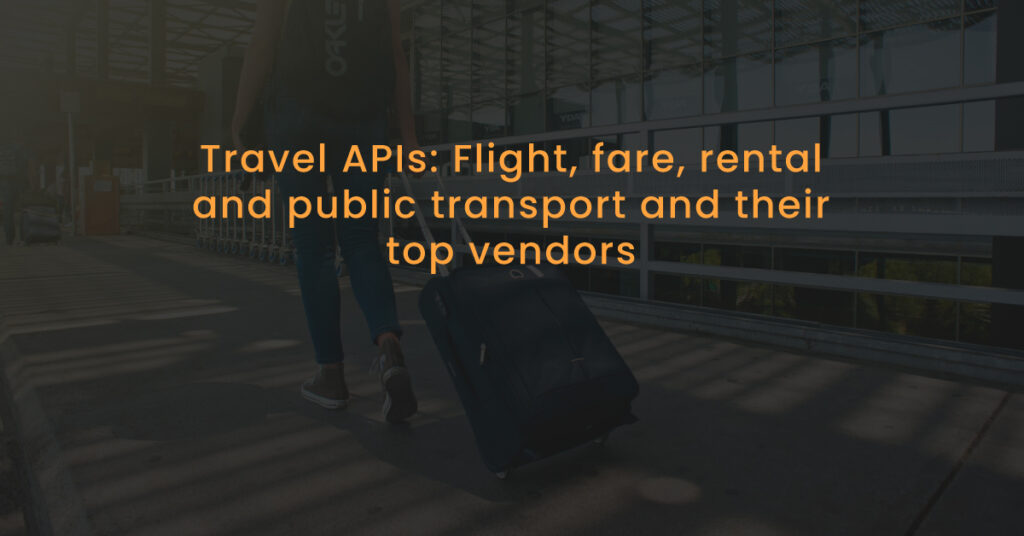
Travel APIs have revolutionized the way businesses in the travel and hospitality industry operate. The rise of Travel APIs across the industry has fueled innovation, and helped online travel businesses target wider markets with high operation capabilities. The travel industry generates a massive amount of data and travel APIs help to streamline this data and provide easy access to it. You can classify these APIs into two categories, Hotel and Room booking APIs, and Non-hotel Travel APIs. If you are looking to read about hotel and room booking APIs, follow our guide, Hotel APIs- 101. In this blog post, we will explain all major non-hotel travel APIs, which include Flight search Flight schedules and fares Car rental Public transport We will also have a comparative look at major vendors providing these non-hotel travel APIs. After accommodation, flight, car rental and public transportation are three other key wheels of the travel industry. And for online travel businesses willing to provide a suite of travel products, custom packages, and tours, organizing these three wheels in sync tends to be the most difficult affair. Not when you have Travel APIs to help you. Flight Search APIs Flight search APIs are one of the most popular travel APIs. They enable travel businesses to provide travelers search for flights based on their preferences, such as departure and arrival cities, dates, flight class, and budget. The flight search APIs provide real-time flight information and allow travelers to compare and book flights from different airlines. When it comes to flight search APIs, the major players in the market are Google Flights, Skyscanner, Expedia, Kayak, and TripAdvisor. Each of these vendors provides a robust and feature-rich flight search API, but they have their own unique strengths, so you have to decide what suits best for your business. Google Flights It is known for its user-friendly interface and accuracy. It provides detailed flight information, including real-time updates and alternative flight options, making it an ideal choice for travel businesses looking for a comprehensive flight search API. Skyscanner It offers a comprehensive flight search API with a focus on price comparison. It provides a wide range of flight options and allows travelers to compare prices and make bookings, making it an excellent choice for budget-conscious travelers. Expedia, Kayak, and TripAdvisor These providers offer a more traditional flight search API, with a focus on flight information and bookings. They offer a wide range of flight options, making it easy for travelers to find the flight that best suits their needs. Flight Schedules and Fares APIs Flight schedules and fares APIs are designed to provide travelers with accurate and up-to-date information about flight schedules and fares. These APIs enable travel businesses to allow travelers to check flight availability, compare prices, and make bookings. They are integrated into various travel websites and mobile applications, making it easy for travelers to access this information. Major vendors providing flight schedules and fares APIs are Amadeus, Sabre, and Travelport. With respect to flight schedules and fares APIs, the major vendors in the market are Amadeus, Sabre, and Travelport. Each of these vendors provides robust and feature-rich flight schedules and fares API, but they have their own unique strengths. Amadeus It is known for its accuracy and reliability. It provides real-time flight information, including flight schedules and fares, making it an ideal choice for travel businesses looking for reliable flight schedules and fares API. Sabre It provides comprehensive flight schedules and fares API with a focus on personalization. It allows travelers to customize their flight search based on their preferences, making it a wonderful choice for travel businesses looking to offer a personalized experience to their customers. Travelport Travelport offers feature-rich flight schedules and fares API with a focus on integration. It integrates with a wide range of travel services, making it easy for travel businesses to offer a comprehensive travel experience to their customers. Car Rental APIs Car rental APIs provide travel businesses with a platform for travelers to search and compare rental cars from different rental companies. They offer a variety of vehicles, from economy cars to luxury cars, and allow travelers to book their preferred vehicle online. Major vendors providing car rental APIs are Hertz, Avis, and Europcar. Each of these vendors provides a robust and feature-rich car rental API, but they all focus on different value propositions. Hertz It is known for its extensive network of rental locations and wide range of vehicles. It provides a comprehensive car rental API with a focus on flexibility, making it a smart choice for travel businesses looking for a flexible car rental solution. Avis It provides a comprehensive car rental API with a focus on quality. It offers a wide range of high-quality vehicles, making it an ideal choice for travel businesses looking for a premium car rental experience. Europcar Europcar provides a comprehensive car rental API with a focus on affordability. It offers a wide range of vehicles at affordable prices, making it an excellent choice for travel businesses looking for an affordable car rental solution. Public Transport APIs Public transport APIs provide information about public transportation services, including bus, subway, and train schedules, fares, and routes. They are designed to help travelers plan their journeys and make informed decisions about the best mode of transport. Major vendors providing public transport APIs are Citymapper, Google Maps, and HERE Technologies. Recommended: Travel content APIs: The need, the market, and the key integrations Wrapping up! Flight, car rental, and public transport APIs offer a range of options to help travel businesses provide a comprehensive travel experience to their customers. The top vendors in each category, such as Google Flights, Sabre, and Hertz, offer unique strengths that cater to the specific needs of different types of travel businesses. As the travel industry continues to evolve, the use of travel APIs will undoubtedly continue to play a critical role in helping businesses thrive and provide unparalleled customer experiences. Vervotech is a leading Hotel Mapping and Room Mapping API that leverages the power of


